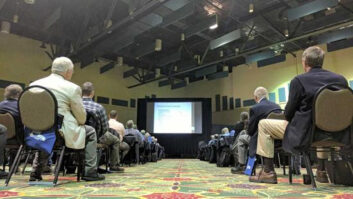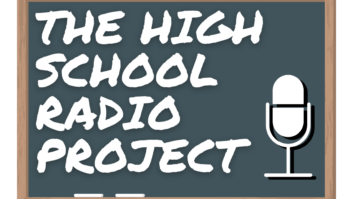The NRB convention opens in Nashville Feb. 27. This story is part of our preview coverage.
Christian radio is different from broader commercial and noncommercial radio in its mission to propagate the faith. But it faces many of the same challenges of its radio brethren, and then some.
Like their secular counterparts, some in Christian radio are pushing the technological envelope, perhaps migrating AM or shortwave broadcasts to FM radio or adding HD Radio broadcasts where money and markets justify the move.

The exposition floor at NRB will be open for three days, Feb. 28–March 2. Consider the example of Crawford Broadcasting Co., which was established by evangelist Dr. Percy B. Crawford in 1958, and owns and operates 24 stations in 10 U.S. markets, including Chicago and Detroit.
“Our company is a mixture of secular and Christian stations, and I can’t really think of anything that stands out as being a special need for the Christian stations,” said Cris Alexander, CBC’s director of engineering, who is also a columnist for Radio World and a recent recipient of the Society of Broadcast Engineers’ Broadcast Engineer of the Year award.
“All but two of our stations are HD; several of the FM stations have multicast channels; all but one stream on the Web.”
Upgrades cost money, which is why another notable broadcaster, Adventist World Radio, is taking a “wait and see” view towards digital media.
“Because our reach is global via satellite, the Web, shortwave radio and local AM/FM stations, we tend to be concerned with changes that will affect the bulk of our audience — which is outside of North America,” said AWR President Benjamin D. Schoun.
“Although HD Radio may prove to be significant in the United States, I believe it will be some time before masses of people have digital radios in Africa and Asia.”
This said, AWR is moving away from its reliance on shortwave signals from its Guam transmitter farm.
“Shortwave still matters, but fewer regulations in many countries is making it far easier for us to acquire local FM stations there. As a result, we now have FM stations in the larger cities of Africa, Asia and Eastern Europe. This makes it easier to reach many more people on their existing radios; they don’t have to buy shortwave receivers.”
Money crunch
Christian radio has taken its lumps during the recession, as secular radio has.
“Of our member stations, it is the commercial Christian stations that have had the hardest time, due to the decline in ad sales that all broadcasters have been facing,” said Craig Parshall, SVP and general counsel of National Religious Broadcasters.
“The noncommercial stations get their money from donors and churches, groups that are more consistent in keeping up their contributions than advertisers are.”
To survive the money crunch, Christian broadcasters are “tightening their belts,” Parshall said.
AWR has taken to piggybacking its audio streams on its TV satellite feeds as part of the trend towards convergence, and moving its African and Asian production offices from England to the regions they serve.
“It just makes sense to produce the content where it is heard,” said Schoun. “Besides, it is much cheaper, in terms of labor and overhead, to produce programming in Africa and Asia.” In the United States, Crawford Broadcasting sees HD Radio as an economical way to improve Christian radio’s reach.
“AM on FM certainly holds promise for many daytime and smaller-market AM stations,” said Alexander. “Our company is utilizing our multicast (HD-2 and HD-3) streams to extend the reach of some of our more challenged signals, effectively extending the coverage of those signals to the limits of the digital coverage of their sister big-gun FMs.”
The Dump button
And then there’s the profanity question. While not necessarily a headliner among technical challenges, it’s always a consideration.
Tech Talk The NRB Show includes a Tech Lab track that promises “three days of first-hand, peer-to-peer advice on all technical aspects of running your media ministry.”
Among sessions of interest: On Sunday Feb. 28, David Pierce and Frank Scales of EMF/K-Love talk about how to use ProTools as a marketing tool to respond to what your audience is doing; they explore how to create podcasts, story songs and promos. Then on Monday March 1, Pierce and Scales talk about how radio stations can produce compelling video content using ProTools and Final Cut.
Other Tech Lab sessions explore data analytics, digital television, lighting a church sanctuary as a stage or studio, open-source Web technologies and Christian gaming. Callers to radio stations can be problematical; that’s why the seven-second delay was developed for talk radio. But according to Alexander, Christian radio’s unabashed morality makes it a particular target for malicious callers armed with F-bombs.
“It would seem that this wouldn’t really be much of a problem for religious broadcasters, but it is an even bigger problem for us than many of the secular folks for a couple of reasons,” he said.
“One is that there are people out there who occasionally work hard to deliberately get past the screener for the sole evident purpose of letting fly the F-bomb on the Christian radio station. The other has to do with our audience, which is much more likely to take notice of an expletive on a station that they believed it was safe to let their children listen to.
“So we have to work much harder to screen this stuff, first with a hyper-diligent human screener and then with 40-second profanity delays that we test and log weekly,” he said.
“Even with all that, it’s impossible to categorically state that a fleeting expletive won’t make it on the air, but at least we can in good conscience say we’ve done our best.”
Despite the economy and the occasional F-bomb threat, Christian radio is persevering, just like its secular cousins.
While AWR continues to move into local FM radio, Crawford has “a couple of studio moves in the works,” said Alexander.
“We are also upgrading one of our AM stations with a nighttime power increase. And we just wrapped up another transmitter site project.
“Despite the economy, life — and the useful life cycle of equipment — goes on.”
A version of this story appeared in the NRB Daily News.












